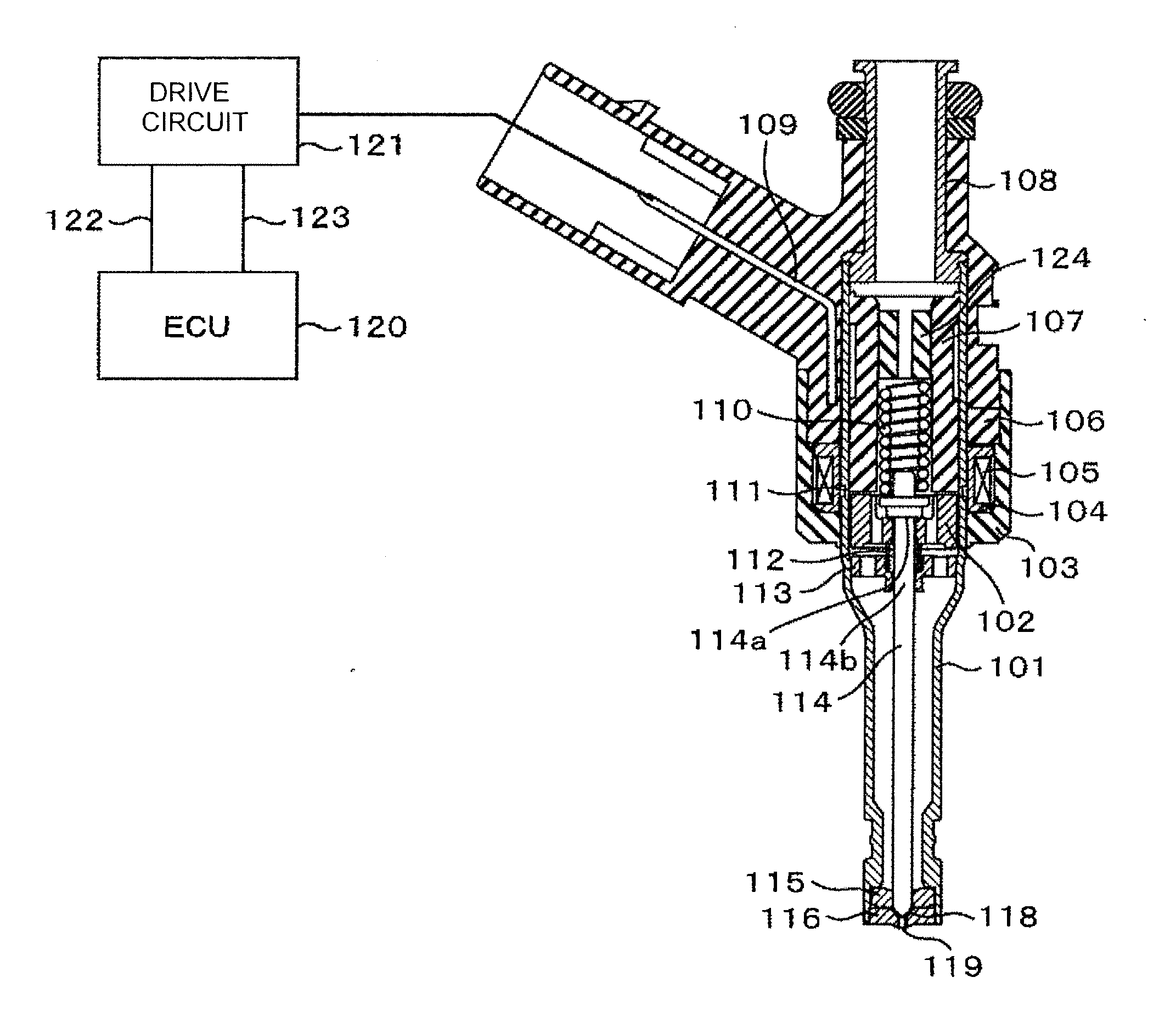Drive unit of fuel injection device
a fuel injection device and drive unit technology, applied in the direction of liquid fuel feeders, machines/engines, electric control, etc., can solve the problems of increasing the minimum injection quantity, and increasing individual irregularities among manufactured fuel injection devices, so as to reduce the minimum injection quantity and the valve element's behavior to be stable.
- Summary
- Abstract
- Description
- Claims
- Application Information
AI Technical Summary
Benefits of technology
Problems solved by technology
Method used
Image
Examples
embodiment 1
[0057]The first embodiment of the present invention is explained in conjunction with FIG. 4 and FIG. 5. FIG. 4 is a graph showing the relationship among an injection pulse outputted from an ECU (engine control unit), a drive voltage and a drive current (excitation current) which are supplied to a fuel injection device, and a displacement amount of a valve element (behavior of the valve element). FIG. 5 is a graph showing the relationship between a pulse width Ti of the injection pulse outputted from the ECU and a fuel injection quantity.
[0058]When an injection pulse is inputted to a drive circuit 121 from an ECU 120, a high voltage 410 is applied to a solenoid 105 from a high voltage source whose voltage is boosted to a voltage higher than a battery voltage so that the supply of an electric current to the solenoid 105 is started. When a current value reaches a preset peak current value Ipeak, the drive circuit 121 stops the applying of the high voltage and sets the voltage to be app...
embodiment 2
[0072]The second embodiment is explained in conjunction with FIG. 6. FIG. 6 is a graph showing the relationship among an injection pulse outputted from an ECU (engine control unit), a drive voltage and a drive current (excitation current) which are supplied to a fuel injection device, and a displacement amount of a valve element (behavior of the valve element). A control of the drive voltage or the drive current explained hereinafter can be carried out using the drive circuit shown in FIG. 8 which is explained in conjunction with the first embodiment by changing a control method (switching timing) of the drive voltage or the drive current.
[0073]When an injection pulse is inputted to the drive circuit, a high voltage 610 is applied to a solenoid 105 from a high voltage source VH whose voltage is boosted to a voltage higher than a battery voltage so that the supply of an electric current to the solenoid 105 is started. When a current value reaches a preset peak current value Ipeak, th...
embodiment 3
[0080]The third embodiment is explained in conjunction with FIG. 7. FIG. 7 is a graph showing the relationship among an injection pulse outputted from an ECU (engine control unit), a drive voltage and a drive current (excitation current) which are supplied to a fuel injection device, and a displacement amount of a valve element (behavior of the valve element). A control of the drive voltage or the drive current explained hereinafter is carried out using the drive circuit shown in FIG. 8 which is explained in conjunction with the first embodiment by changing a control method (switching timing) of the drive voltage or the drive current.
[0081]The point which makes this embodiment differ from the first embodiment lies in that when a current value reaches a preset current value 713, a drive circuit 121 performs a control such that a high voltage source VH is applied by switching so that a predetermined electric current 702 is held for a fixed time. Advantageous effects acquired by holdin...
PUM
 Login to View More
Login to View More Abstract
Description
Claims
Application Information
 Login to View More
Login to View More - R&D
- Intellectual Property
- Life Sciences
- Materials
- Tech Scout
- Unparalleled Data Quality
- Higher Quality Content
- 60% Fewer Hallucinations
Browse by: Latest US Patents, China's latest patents, Technical Efficacy Thesaurus, Application Domain, Technology Topic, Popular Technical Reports.
© 2025 PatSnap. All rights reserved.Legal|Privacy policy|Modern Slavery Act Transparency Statement|Sitemap|About US| Contact US: help@patsnap.com



